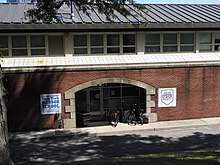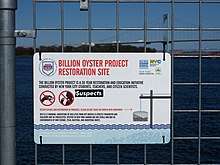Billion Oyster Project
The Billion Oyster Project is a citizen science project co-ordinated by the New York Harbor School with the goal of restoring one billion live oysters to New York Harbor by 2035. The project aims to engage hundreds of thousands of school children during its lifetime in marine restoration-based STEM education programs. The project grew out of the activities of students at the New York Harbor School who started growing and restoring oysters in New York Harbor in 2008.[1]
 | |
| Formation | 2008 |
|---|---|
| Founder | New York Harbor School |
| Location |
|
Key people | Murray Fisher,Peter Malinowski |
| Website | billionoysterproject |
History
The project was inspired by the success of the Oyster Recovery Project[2] based in Chesapeake Bay which has to date replanted more than 6.7 billion oysters on 2,200 acres (8.9 km2) of oyster reefs. Oyster reefs are thought to have covered more than 220,000 acres (890 km2) of the Hudson River estuary and filtered water, provided habitat for other marine species and attenuated wave energy but are now functionally extinct in the Harbor due to over harvesting, dredging and pollution.[3]
The project was the brainchild of educators Murray Fisher and Peter Malinowski who are both associated with New York Harbor School and its foundation and was formally established in 2014. A $5 million National Science Foundation grant will allow the program to spread to thousands of public middle school students from 2015.[4]
Achievements

As of November 2019, more than 30 million oysters had been restored to NY Harbor, with 7 acres (28,000 m2) of reef area restored. More than 6,000 high school and middle school students have taken part in the project. Approximately of oyster shell have been recycled. Co-ordinators estimate the oysters have filtered approximately 10.9 trillion US gallons (41×1012 L) of water in New York Harbor, removing 6.75 million pounds (3.06×106 kg) million pounds of nitrogen. In 2020, expansion into mobile spawning tanks at Red Hook, Brooklyn, allowed for significant increased in capacity by the organization.[5]
Projects
The Living Breakwaters is a project in Staten Island that uses Oysters or oyster-tecture to protect from storm surge, increase biodiversity, clean water, and create educational opportunities. Living Breakwaters will work under the guidance of the Billion Oyster Project, a company that has done similar projects many times all over the shores of the world. This project is in part funded by the federal Department of Housing and Urban Development. They have contributed $60 million partly for the purpose of disaster recovery, but also to prevent the same disaster in the future. Staten Island was greatly affected by erosion and flooding in Hurricane Sandy in 2012, particularly the south shore of Staten Island.[6] This project will start in Tottenville.[7] Tottenville used to be famous for their oyster population and this project aims to bring back the presence of that marine life. It is a solution that uses natural reentry of a previously existing population rather than risking an invasive species.[8] The process that the Billion Oyster Project plans to go through starts with more than 70 New York restaurants saving their oysters shells. Then those shells are left outside for a year to be cleaned completely organically and to rid the shells of any human chemicals. Baby oysters are then placed in the shells. The oysters are young and won’t be able to fight off any chemicals. The larvae are placed in the shells at New York Harbor School. This is a public high school focused on marine life.[9] The oysters will be placed on to a wall made of low acidity permeable concrete.[10] Local Tontenville elementary school teacher, Deb Amoroso, has received training from the Billion Oyster Projects and will monitor the growth of oysters with her class. They will help collect shells to install as well as watch (and discuss) the progress of the ecosystem.[11] The plan for Living Breakwaters is all encompassing. It includes the steps of reducing risk and fragility, building up ecology leading to greater biodiversity, and benefiting the surrounding area through community partnering.[12] The oysters on the wall will create a strong and more natural barrier as a form of risk management for the rise in storm frequency and sea level rise with climate change. The oysters will bring in their prey as well as naturally filter the water making it more attractive to marine life. This growing ecosystem is a large opportunity for local classrooms to get involved and see marine biology in action. The people have a voice in the project too. The Living Breakwaters citizens advisory committee was established in 2015 and looks to gather opinions of the locals on decisions through the project.[13] Project construction is supposed to start in late 2019.[14]
References
- "Billion Oyster Project".
- "Oyster Recovery Project". Retrieved 21 January 2019.
- Karen Tedesco (1 June 2015). "A BILLION OYSTERS TELL THE HISTORY OF NEW YORK". The Village Voice.
- Sybile Penhirin (October 30, 2014). "Billion Oysters Project $5M Grant". DNAinfoNY. Archived from the original on September 23, 2015.
- "Shipping Containers Turned into Oyster Tanks in Brooklyn". www.ny1.com. Retrieved 2020-08-05.
- Wattles, Jackie. "Cleaning New York's filthy harbor with one billion oysters". CNN. Retrieved 2019-11-20.
- "Living Breakwaters". Rebuild by Design. Retrieved 2019-11-20.
- Michelle, Cohen. "Living Breakwaters: An Award-Winning Project Brings 'Oyster-tecture' to the Shores of Staten Island". 6sqft. Retrieved 2019-11-20.
- Wattles, Jackie. "Cleaning New York's filthy harbor with one billion oysters". CNN. Retrieved 2019-11-20.
- Appelbaum, Alec. "New York's Big Climate Plan Really Does Include Oysters". citylab. Retrieved 2019-11-20.
- Appelbaum, Alec. "New York's Big Climate Plan Really Does Include Oysters". citylab. Retrieved 2019-11-20.
- Greenberg, Paul. "Living Breakwaters" (PDF). Rebuild by Design. Retrieved 2019-11-20.
- The Official Website of New York State https://stormrecovery.ny.gov/LBWCAC. Retrieved 2019-11-20. Missing or empty
|title=(help) - Wattles, Jackie. "Cleaning New York's filthy harbor with one billion oysters". CNN. Retrieved 2019-11-20.